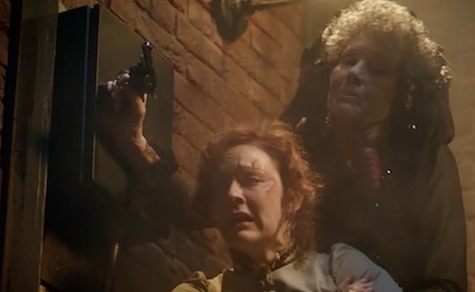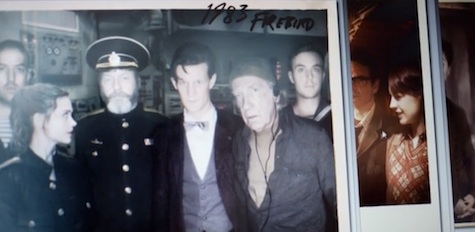Some of the most beloved episodes of Doctor Who from across its entire run have been moody gothic numbers, evoking a Sherlock Holmes meets monster-centric sci-fi vibe. In the Tom Baker adventure, “The Talons of Weng-Chiang,” the Fourth Doctor even dons a full on Sherlock Holmes costume, echoed in the recent Christmas special by Matt Smith parading around in a deerstalker and cape. But these days, the detecting in a Victorian setting is done by the reptilian Madame Vastra and her gal pal Jenny. Along with the Sontaran Strax, they’re back for the latest Who goes gothic adventure. All the ingredients are there for a classic by-the-numbers Doctor Who story. Did it work?
Without being too dramatic, the answer is no. This episode had everything going for it in terms of mood, casting, character and concept, and yet it was poorly structured, sloppily executed, tonally erratic, and worst of all, dull.
Oddly, the plot of this episode is revealed in a roundabout way. The story is initially told through the perspective of Victorian-era dwelling Madame Vastra and her wife Jenny taking on an investigation because the image of the Doctor was found in a dead man’s eye. The case leads them to a strange cult called Sweetville which echoes aspects of the Temperance movement. Its leader is the creepy, preachy Mrs. Gillyflower, played wonderfully by Dame Diana Rigg. In almost every sense, Rigg’s cackling performance is the bright spot of this episode. You’re convinced she’s crazy and evil and she comes across as genuinely scary.

And though her plot is unveiled in a weird roundabout fashion, it is essentially to kill the majority of the world off with some red venom from the dinosaur times by launching a big rocket over the planet. She’s been preserving “perfect” people who will emerge into her brave new world. This is basically the same thing the bad guy wanted to do in the James Bond film Moonraker. I guess I like this connection because Diana Rigg was of course in the real Avengers and also played Tracy in the Bond film On Her Majesty’s Secret Service. I say this because I’d rather watch any of those things than this episode.
So much of “The Crimson Horror” could have been good, but the idea that a lot of these people are turned red by the ancient red venom is really, really hokey. We know Doctor Who is supposed to be silly, but when Jenny eventually finds the Doctor, Matt Smith’s lurching Frankenstein bit really, really tests your patience. Further, I sort of assumed the episode would have a kind of Doctor-lite feel to it, with Jenny, Madame Vastar, and Strax sort of taking center stage.

The episode pretty much splits the difference here and almost doesn’t seem sure who to focus on. I find myself saying this a lot about the Stephen Moffat era, but really, why are there so many characters in this episode? The super-screwed up relationship between Gillyflower and her daughter Ada (played by Rigg’s real life daughter, Rachael Stirling) seems sort of drowned out by all the other very big characters. I liked this character and enjoyed her immediate love of the Doctor and her calling him her “monster.” But there was so little time spent on her, that I wasn’t sure how to feel in the end.
And while I loved Strax’s outburst of “Horse, you have failed in your mission!” I don’t really find him all that funny. He’s like that character from Police Squad Police Academy—Tackleberry—where the joke is just talking about weapons all the time. His randomly calling some women “boy,” is also sort of tiresome, and also confusing, as he was able to identify Diana Rigg as a “human female.” Point is, I like it when Strax is saying things about breast-feeding human babies in a militant voice, rather than just constantly suggesting grenades or whatever in every single situation. Jenny and Madame Vastra are cool enough on their own, I’m not sure I need him, too.
My favorite part of the episode was easily the old-timey sepia film section in which the Doctor recounts to Jenny how he got in the situation he’s in. It’s cute, and looks great, but it also simultaneously shows the cracks of what’s wrong with this episode. After the Doctor tells us how he got where he is, the rest of the episode lacks mystery. Sure, we still don’t know who Mr. Sweet is, but for the most part, the whole mystery of the episode is solved WAY before the episode ends, meaning the tension is sort of drained out of the rest of the episode. If you’ve watched Doctor Who before, you know the rest of it will just be a lot of running around and sonic screwdriver-brandishing. Like the old-timey movie section, everything here looks good, but is ultimately a little tensionless.

Imagine if the episode hid the Doctor for much longer, and the mystery about Ada’s monster grew and grew. What if the red venom truly had turned the Doctor into a monster, leaving Jenny, Vastra, Strax and Clara to figure out how to deal with him? In that kind of scenario, Diana Rigg’s plot would become way scarier, and you’d actually be worried about her spreading the red venom to everyone. As it stands, the episode seems hastily written, and sort of confused. Also, it was kind of gross. When the little parasite was revealed to be sucking on Diana Rigg’s chest, I didn’t think it was creepy, just gross!

What were these beautiful giant phonographs for that Jenny discovered? I loved these. They looked like an art installation I’d see at the Dia Art Museum or something. Explain these things to me, Mark Gatiss!
Because it was tensionless, “The Crimson Horror,” was simply a missed opportunity. It was nice to see Jenny and Madame Vastra again, and I enjoyed the Holmesian quality of the initial mystery. But because the plot was mismanaged, and a bit generic, the episode probably won’t enter into the same category as other much-loved gothic Who outings. Which is too bad, because all the ingredients were there. I feel like if there was just a slight re-write and re-ordering of events, this one would have been WAY better.

What did we learn about the mystery of Clara this time? Very little, but the kids Clara nannies for learned a lot about her!
- The kids know now Clara is a time traveler, they’ve found pictures.
- Clara sees a picture of herself in Victorian London, which wasn’t where she recently was, freaking her out about her future.
- The Doctor calls Clara, “The Boss,” a notion which she cutely repeats later.
- Awesome references to old school companion Tegan! Matt Smith references an “Aussie,” and also says, “Brave heart, Clara,” which was the Fifth Doctor’s catchphrase with Tegan.
Next week, it looks like the kids are jumping on the TARDIS for a new Cyberman adventure. Come on Neil Gaiman! Let’s salvage this lame-duck season with an AWESOME Doctor Who episode!
Ryan Britt is a longtime contributor to Tor.com.










